'Cinderella' - biaxial liquid crystal - is found at last

Recent research at the DUBBLE beamline has proved the existence of liquid crystals with two main axes. Liquid crystals with a single main axis are already used in LCDs (liquid crystal displays), but crystals with two main axes can make computer monitors and optical switches much faster, as well as opening doors to new 3D technologies.
For decades, researchers have been on a quest for the 'Cinderella' of liquid crystals, a so-called biaxial liquid crystal. Some years ago, the formation of such liquid crystals with two main axes by complex banana-shaped molecules was reported. However, these results were contested, as some researchers believed that the observations might have originated from the complex internal structure of the crystals, which are not necessarily biaxial.
Researchers from Utrecht University, The Netherlands, have now proved the existence of biaxial liquid crystals in a much simpler system of inorganic colloidal particles, which are able to spontaneously form biaxial liquid crystals. The proof was obtained using DUBBLE, a facility which allows Dutch and Flemish researchers to experiment using X-rays at the ESRF (European Synchrotron Radiation Facility) in Grenoble, France.
If you press your finger onto an LCD screen - which is not actually recommended - you’ll see some movement around the finger. This is because of the liquid crystals (LCs), which can flow like a liquid. However, in contrast to ordinary liquids, LCs consist of elongated molecules which all face the same way along the main axis. The properties of LCs are therefore anisotropic. For instance, the refractive index for light depends on whether the light is polarised along the main axis or along the other two directions. You can adjust the direction these molecules face using electric voltage. These effects are exploited in your LCD screen to manipulate light with electric signals to produce the image.
The molecules in the liquid crystals in your LCD screen arrange themselves along a single axis. Rod-like molecules align their long side parallel to each other while they can easily rotate in the other directions. There are also LCs formed by disc-shaped molecules, which align their shortest sides parallel. In both cases, the length or width is clearly different from the other two dimensions. It was predicted as far back as forty years ago, however, that molecules with different lengths, widths and thicknesses would be able to align along both the longest and shortest axes. This theory has now been proved for the first time during experiments with the DUBBLE beamline.
The scientists studied spontaneous formation of liquid crystals by disc-like particles of the mineral goethite. They used X-rays at the DUBBLE beamline to reveal the 3D structure of the liquid crystals. In the nematic phase the particles appeared to be able to align in all three dimensions, the length, the width and the thickness, parallel to each other. The prediction from 40 years ago was finally confirmed. The research results were published in December 2009 on the cover of the prestigious journal Physical Review Letters.
The particles of goethite with a simple disc-like shape have now provided the first clear proof for biaxial structure. However, the particles that the researchers used for their experiments are not immediately usable for new screen or super-fast optical switches just yet. These particles absorb too much light, and they are still a bit too large and therefore too slow. The principle is extremely promising, however.
DUBBLE (the Dutch Belgian Beamline) is one of the thirty measurement facilities around the synchrotron ring at the European Synchrotron Radiation Facility (ESRF) in Grenoble. DUBBLE can access the X-rays that are generated by the ESRF synchrotron for research purposes. The radiation is particularly intense and covers virtually the full wavelength of the electromagnetic spectrum. Using X-ray scattering, scientists can study structures between 1 and 1000 millionths of a millimetre (i.e. 1 nanometre to 1 micron) in size. Over the past four years, scientists have used this technique to investigate materials such as large proteins, liquid crystals, colloidal crystals, supercooled water, polymers and skin.

















